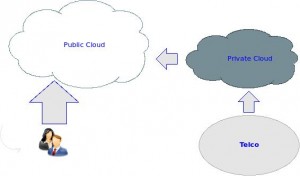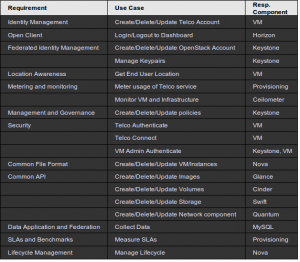Dependability Modeling is carried out in 4 steps: model the user intercations, model the system functions, model the system services and then model the system components which make system services available. In the first part we will define which interactions could be expected from end users of the OpenStack cloud platform and construct the first part of the dependability graph. Once the dependapility model is constructed, a Dependability Analysis will be performed and several OpenStack HA architectures will be rated according to their outage risk.
Before we can define use cases for an OpenStack HA environment, we must first think about its Deployment Model. According to the Use Cases Whitepaper of the Open Cloud Manifesto, every cloud has its own use case scenario which depends on its “Cloud Deployment Model”. A Cloud Deployment Model is a method which describes the way how the cloud is deployed in an organizational context. The US National Institute of Standards and Technology (NIST) has published a definition paper which describes essential characteristics of cloud computing as well as possible types of Service and Deployment Models for cloud environments. According to the NIST definition of Cloud Computing, there are four types of Cloud Deployment Models:
- Private Cloud: The cloud infrastructure is operated for one single organization inside that organization’s firewall. All data and processes are managed within the organization and are therefore not exposed to security issues, network bandwidth limitations or legal restrictions (in contrast to a Public Cloud).
- Community Cloud: The cloud infrastructure is shared by several organizations and has the purpose to support a specific community of end users who have shared concerns. Typical Community Clouds are e. g. Googledocs, Facebook, Dropbox.
- Public Cloud: The cloud infrastructure is made available to the general public and is owned by a cloud provider organization.
- Hybrid Cloud: The cloud infrastructure is a composition of multiple other clouds (private, community or public) that remain unique entities but are bound together by technology that enables interoperability.
According to this definition, the MobileCloud Networking (MCN) infrastructure is rather a Hybrid Cloud. On one hand MCN is used as a Private Cloud for the Telcos to manage their infrastructure environment and handle peak loads or infrastructure-based network issues. On the other hand, the MCN is a Public Cloud for the Mobile End Users: they request communication services from the Telco sites, register and authenticate themselves and consume the communication service offered by the Telco. Mobile End Users produce the load on the Telco managed infrastructure. The MCN is deployed in an “Enterprise to Cloud to End User” scenario (Fig. 1).

Typically the Enterprise to Cloud to End User Scenario requires the following features:
- Identity Management: This is performed by the authentication services provided by the Telco. Authentication services run inside the virtual machines provided by OpenStack.
- Use of an open client: Management of the cloud should not depend on a particular platform/technology. In OpenStack this is guaranteed by using the Horizon Dashboard.
- Federated Identity Management: Identity of Telco users should also be managed in parallel to end users. In OpenStack Telco users are managed by the Keystone component. End users are authenticated in the virtual machines provided by the Telco.
-
Location awareness: Depending on the legal restrictions in the Telco industry, data of end users must be stored on particular physical servers. Therefore the cloud service must provide awareness of the location of end users.
-
Metering and monitoring: All cloud services must be metered for chargeback and provisioning. MCN uses a provisioning facility for this task.
- Management and Governance: It is up to the Telcos to define Governance policies for the VMs managed by OpenStack. Policies and rules can be configured via Keystone.
- Security: The OpenStack cloud network should be secured against unauthorized access. Security is a typical Keystone task.
- Common File Format for VMs: The infrastructure of Telco organizations might be heterogenous. For reasons of interoperability the file format of VMs used in the MCN cloud should be interchangeable. Nova is the computation component of the OpenStack framework. Nova is technology-agnostic and therefore offers VM-interoperability between many different VM-systems like e. g. KVM, Xen, Virtualbox etc.
- Common APIs for Cloud Storage and Middleware: OpenStack offers a common API for Cloud Storage: Images are stored and managed by the Glance component. All objects managed in the cloud are stored with the Swift API. Block storage is managed by Cinder.
- Data Application and Federation: All cloud data must be federated in order to manage the cloud infrastructure. In OpenStack cloud data is managed by a MySQL server.
- SLAs and Benchmarks: The OpenStack environment must fulfil SLAs with the end users as well as OLAs with the Telco itself. SLAs can be metered by the MCN provisioning facility.
- Lifecycle Management: The lifecycle of VMs must be managed also in the MCN infrastructure. Lifecycle Management is also a task of Nova component.
If we follow the list of requirements we can define use cases for the OpenStack environment of the MobileCloud Network (Tab.1). The result is a list of use cases which define the user interactions with the OpenStack cloud.

Modeling the user interactions is the first step in Dependability Modeling. In order to get a full Dependability Model of the OpenStack environment we must investigate the functions and services which make the user interactions available. A further post will show how this is done.
1 Kommentar